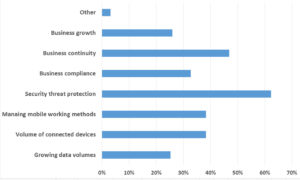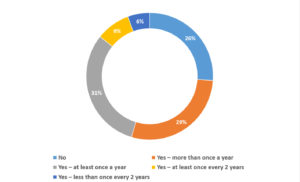“There’s a disconnect here between the fact that three-quarters of organisations have said that they want to be freed up to add value to their organisation, and that organisations are still only allocating a fraction (on average 28%) of their overall IT budgets to MSPs. This is perhaps a symptom of a cost based managed service model where the selling point of the MSP is cost reduction rather than delivering value as a return on spend,” she said.
Respondents indicated that the most important service provided by their MSP was active identification of issues and remediation (54%), followed by best practice expertise and advice (45%), and software patching and updates (40%). These were followed by break/fix services (43%), external helpdesk (31%) and additional capacity at peak times (22%).
“Starting with the ‘break/ fix’ option,” O’Connor noted, “this is a typically reactive service often considered low value. It can, for a low value element, also be high cost if not delivered through an efficient model and hence often an outsourced model has the least risk.
“When it comes to actively identifying IT issues and remediation (54%), and providing best-practice advice/ expertise (45%), these are the areas in which MSPs can really show their worth. Many organisations may be comfortable having an in-house helpdesk, but they might start to struggle when it comes to high level support and expertise around specific technologies; this is where a shared service model can work well. It is also where they can draw impartial expert advice around industry best practice and future technology roadmaps.”
Even with the extensive use of managed services, fears and reservations remain. The top three that emerged are old favourites: loss of control (58%), increased costs (54%) and lack of communication and feedback (51%), though loss of visibility came a close fourth (47%). Among the others mentioned vendor lock-in and security fears in general.
“When it comes to organisations fearing that they will lose control or experience a lack of communication/feedback from the service provider, this is where the MSP must do everything in its power to alleviate concerns and this is an area that Datapac invests heavily in, from team training and technology platforms to its tailored approach to service level agreements,” said O’Connor.

With regard to changing technology trends and work practices, which of the following areas are you most likely to seek external support and/or management? (Select three)
“A real time client portal, for example, is a good way to reassure end users by giving them access to live updates on their tickets directly as they are being worked on by the engineer. Such accessibility, coupled with service level agreements that set clear customer driven expectations in term of deliverables and transparent reporting, allows customers to come to an understanding with their MSP about what is important to their organisation, and allows them to maintain an element of control.
A factor in the continuing workload of IT is increasing data volumes, and the majority of respondents (64%) indicated that the volume had increased between 10 and 50%, with nearly a quarter (23%) indicating a greater volume increase. Just one in 10 saw no increase, with an unsurprising 3% seeing any reduction at all.
With back-up and continuity featuring so highly in managed service adoption, respondents were asked about recovery times from a mission critical data loss. Encouragingly, nearly three quarters (73%) measured the time in just hours, while 15% said up to two days, with 8% indicating up to a working week (5 days). A worrying 5% said more, up to a month.
However, in stark contrast to expectations for data recovery, more than a quarter (26%) of respondents said they do not carry out a full disaster recovery test. Nearly a third (29%) said they did more than yearly, with a similar proportion (31%) saying they did so at least yearly. Some 15% did it every two years or less.
Mobile working is also highly prevalent among the organisations polled, with the vast majority (77%) agreeing that it was becoming increasingly so, but nearly a third (32%) felt that they had insufficient technology platforms and support structures in place to manage it effectively.
Added to this, were the expected technology trends and work practices that are most likely to prompt organisations to seek external support in the future, and the picture becomes complex.









Subscribers 0
Fans 0
Followers 0
Followers